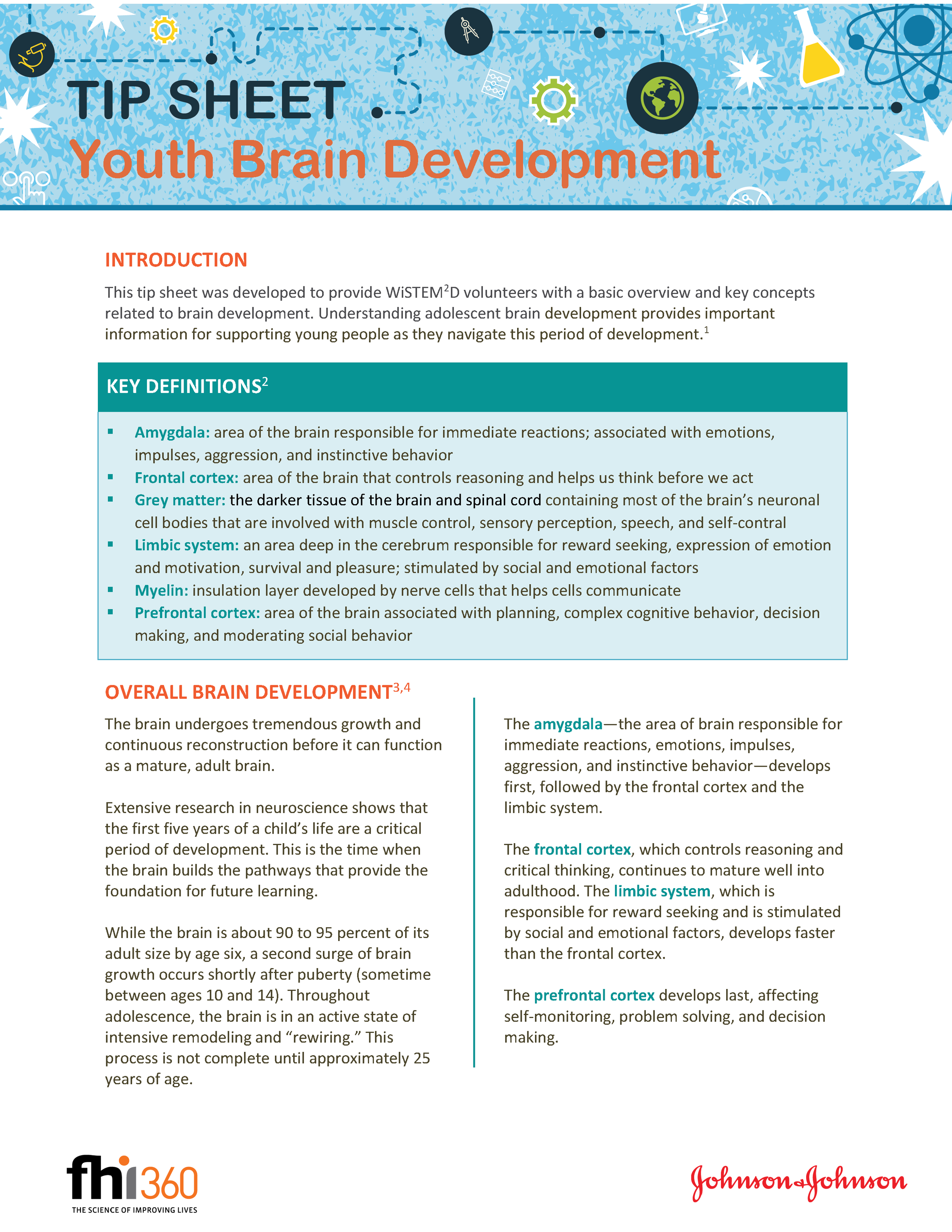
Get Involved
Sparking Kids’ Interest in STEM²D
Sparking kids’ interest in STEM²D starts with nurturing their “STEM²D identity,” a phrase that refers to the ways students think of themselves in relation to STEM²D and the extent to which they have developed a commitment to, are engaged in, and see value in STEM²D. Young people may have a conflict between their self-identity (“people like me”) and their perception of who does STEM²D (“not people like me”). They struggle to identify with STEM²D culture and professionals.
You can nurture a positive STEM²D identity and spark a lifelong interest in STEM²D by cultivating:
Interest: Young people who are interested in STEM²D like to do STEM²D. They are excited about it, express curiosity in STEM²D subjects, and want to try more activities. In fact, elementary school students who show this kind of interest report taking further STEM²D classes in middle or high school.
Confidence: Young people who have confidence in their abilities can do STEM²D. They will persist in the face of initial failures. This is an essential feature of a growth mindset—the idea that ability and competence grow with effort. Research points out that with a growth mindset (as opposed to a fixed mindset), you believe that the harder you work, the smarter you grow. People with a growth mindset are more persistent, are encouraged by failure, and choose challenging work and subjects to study, like STEM²D.
Relevance: Young people who understand the relevance and value of STEM²D want to do STEM²D. They understand STEM²D’s relevance in contributing to society and solving global and local problems, and they see how STEM²D intimately connects to their everyday lives.
The following additional strategies can be used to encourage and engage young people in STEM²D. (Click on the three dots to expand each section.)
To spark young people’s interest with STEM²D subjects, we need to reach them where they are—in urban centers, small towns, villages, and rural communities. STEM²D must be accessible and available in a broad variety of places or settings: in schools, after-school programs, community-based events, museums, libraries, business conference rooms, and village squares. There are many ways to engage with this initiative, whether you want to help plan an event, share your career journey, present material in a school setting, organize a learning experience at your company for young people, or become part of a strategy team.
By scrolling below, you’ll find resources, tools, tips, and strategies to support you in WiSTEM²D volunteer experiences. You can also jump to the following sections:
Volunteer Tip Sheets | Country-Specific Career Insights | Volunteer PowerPoint Presentation Template
-
It is important to remember that during the time—even minimal amounts—spent with young people, you can serve as a role model. Exposure to role models has been shown to improve performance on tests and to invalidate stereotypes. No matter which STEM²D category, a role model can be found. It is important to show and teach the stories of professionals in STEM²D.
Key strategy: Provide meaningful advice. No two people or communities are alike, and no single activity or talk will meet the needs of all young people.
-
All volunteers can greatly enrich their time with young people by drawing on and sharing their own experiences. The Tell My Story Form supports and encourages volunteers to develop their STEM²D story and share their accomplishments in a relevant and personal way. These shared experiences provide an opportunity for you to have an impact and help girls establish a positive STEM²D identity.
Key strategy: Young people have unique social, personal, and academic needs. Approach them with sincerity and respect. Learn their names, encourage their participation, and connect the activities to young people’s current and future needs.
-
If you have ever learned to play a musical instrument or participated in a team sport, you know that it takes time, effort, and practice to succeed. The same is true of STEM²D subject abilities: They improve through consistent effort and learning. Knowing the right answer may make students feel smart, but what happens when there is no right answer? Then students need to problem solve, which takes a lot of time and effort. Such problem solving can be very intriguing to young people. It is important for kids to know that cognitive abilities are not fixed or determined by gender. Encourage kids to be curious, take an interest, ask questions, and seek environments that fosters those aspects of learning.
Key strategy: Teach kids that working hard to gain knowledge improves performance.
-
Everyone likes to hear, “good job” in terms of their performance. However, try to amend their feedback when it comes to encouraging young people’s abilities. A simple “good job” doesn’t tell them why they are doing well, which is important in building kids’ confidence. Furthermore, stating that an answer is incorrect with no explanation can lead them to believe they lack the ability to get it right and cannot do math and science. Informational feedback on effort and content—such as, “You worked really hard to solve that problem” or “Review your calculations in Step 3; there is a minor multiplication error”—positively influences kids’ beliefs about their abilities. This is an important strategy to keep them interested in solving challenging problems.
Key strategy: Provide kids with positive feedback about why they are doing well and specific information about how to make corrections.
-
Kids perform well on tests closely related to school-taught curriculum. However, questions on standardized tests do not closely match day-to-day learning. Researchers have found that spatial skills (the capacity to understand, reason, and remember the spatial relations among objects or space) are associated with performance on math tests and that spatial skills can be improved with practice. To improve spatial skills, encourage kids to design and build things. Emphasize skills like mental visualization of what objects look like when they are rotated in space. Even at the earliest ages, increasing spatial skills is shown to improve standardized test scores later in their primary and secondary education.
Key strategy: Have kids answer math and science problems using both verbal responses and spatial displays.
-
Some students are naturally interested in tinkering and technology. Others have more artistic or humanitarian interests. To cultivate a long-term interest in STEM²D, exercise creativity by embedding STEM²D into fantasy scenarios, real-world problems, popular culture, and even day-to-day life. Literacy also plays a large part in this recommendation. Kids also respond well to strategies that integrate literacy with science. Reading informational text is important in the context of science because reading is something scientists do. Informational text can generate interest and further curiosity, provide data and evidence to explain phenomena, and provide the context for defining problems.
Key strategy: Embed tinkering, creativity, and literacy into science activities in contexts that are interesting to kids.
If you rather read through this information in guidebook-form, download the SPARK WiSTEM²D Resource, available in English, Arabic, Chinese, French, Portuguese, Spanish, and Russian. You’ll find a definition of STEM²D principles and philosophy, statistics on the STEM²D labor market and career options, research-based strategies and tips for engaging kids, tips and practical ideas for talking about yourself and your career path, and more.
Volunteer Tip Sheets
In this section, you'll find tips and strategies on various topics related to encouraging, engaging, and communicating with young people. Below, you can download tip sheets: Engaging Youth, Messaging for Parents, and Youth Brain Development. Tip sheets are available in Arabic, Chinese, English, French, Russian, and Spanish.

Country-Specific Career Insights
The global demand for STEM²D talent is growing. Experts indicate that almost all of the 30 fastest-growing occupations in the next decade will require at least some background in STEM²D, but for many kids who start out strong in mathematics and science, interest wanes along the way. As a result, many women leave STEM²D fields. The number of available STEM²D jobs, however, will continue to grow.
Find out more about career prospects for specific countries in Europe, the Middle East, Africa, the Americas, and Asia Pacific.

Presentation Template
Have you been asked to give a presentation on the WiSTEM²D initiative or your STEM²D volunteer experience? Download a PowerPoint designed just for you, including many of the fun elements you find in the WiSTEM²D resources.




